"Because practical applications are so remote, many people assume we should not be interested. But this quest to understand the world is what defines us as human beings." -Yuri Milner
It’s been another big week here at Starts With A Bang, with stories covering the Universe near and far. First off, thanks to our generous Patreon supporters, we have a brand new podcast live today, on whether the Big Bang was really the beginning of the Universe.
- How many stars visible in the night sky still exist? (for Ask Ethan),
- Viewing the Earth from space celebrates 70 years (for Mostly Mute Monday),
- How the last great american eclipse almost shocked Einstein,
- What an Earth-like world around Proxima Centauri would (and wouldn't) mean,
- How science could learn more about Proxima b and all Earth-like worlds, and
- NASA's revived STEREO-B could save us from a trillion dollar disaster.
The number of comments might have been low this week but the quality was high! Let’s see what fantastic things I can make happen on this edition of our comments of the week.
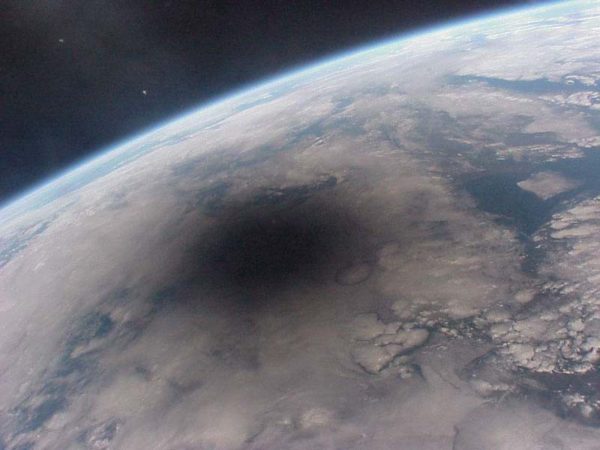 Image credit: Mir / RSA, 1999, of the Moon's shadow falling on Earth, during a total solar eclipse as seen from space.
Image credit: Mir / RSA, 1999, of the Moon's shadow falling on Earth, during a total solar eclipse as seen from space.
From PJ on my present for the next year: "Happies again, Ethan. For next year, your present, should you accept it, is a total solar eclipse on Aug 21, 2017. You will not have to drive far to be on the centreline. Just a shame it will not be long lived – ~ 2 mins."
So my birthday is August 3rd, for whatever that means. I have seen two solar eclipses in my life: a partial one in 1994 (that was significant, at about 88% where I was) and an annular one in 2012, where I did something I practically never do, and actually took pictures.
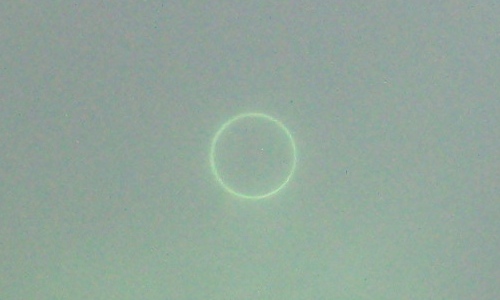 Taken with a digital camera through shade 5 welder's glass, while the Sun was behind a thin layer of clouds. Image credit: E. Siegel, 2012.
Taken with a digital camera through shade 5 welder's glass, while the Sun was behind a thin layer of clouds. Image credit: E. Siegel, 2012.
I definitely have plans to go see this next eclipse, which is the first total solar eclipse occurring over any part of the country I live in since I was ~1 year old. Most likely, you can look for me in the foothills of Mt. Jefferson, although there's also a chance I'll be closer to Eugene, OR. Either way, I'm incredibly excited for it! My goal -- and I don't know if it'll achieve appropriate levels of darkness -- is to see an actual star during the eclipse. We'll see!
From See Noevo on what it means to be a cylon: "Spoken as an honest, transparent evolutionist."
That's not the context of this at all. (See the video above.) So the quote was:
I saw a star explode and send out the building blocks of the Universe. Other stars, other planets and eventually other life. A supernova! Creation itself! I was there. I wanted to see it and be part of the moment. And you know how I perceived one of the most glorious events in the universe? With these ridiculous gelatinous orbs in my skull!
It's not about evolution at all, but rather how this artificial being was placed into a human body that was created for him by other artificial beings, and is struggling with the limitations of his existence. How limiting it is to only have the senses of a human, the experiences of a human, the body of a human, etc., given all that there is going on in the Universe that are beyond our senses. And the more we learn about what's out there -- dark matter, dark energy, the missing baryons -- the more we learn about what we're missing given our limited senses. Which makes what we can perceive all the more amazing. But I am sure you aren't hear to listen to my philosophies on things, so it's onto the next one.
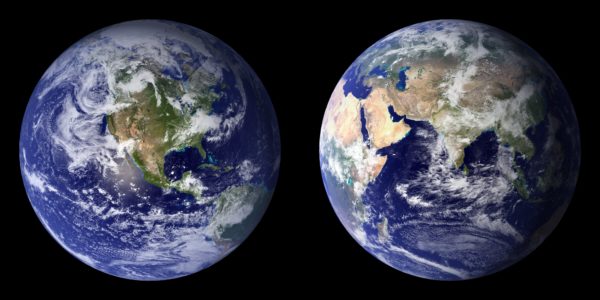 The 2001-2002 composite images of the Blue Marble, constructed with NASA's Moderate Resolution Imaging Spectroradiometer (MODIS) data.
The 2001-2002 composite images of the Blue Marble, constructed with NASA's Moderate Resolution Imaging Spectroradiometer (MODIS) data.
From Denier on viewing the Earth from space: "We’re actually tighter than that and the advancement is due mainly to the relaxing of US law. Most of the stuff we see on Google Maps is from DigitalGlobe Quickbird satellites, which had a detail resolution down to 0.6m per pixel (with a 2.4m per pixel color overlay). However with new changes to US law DigitalGlobe’s new satellite resolves down to 30cm per pixel."
It is amazing how quickly resolution from camera technology is evolving, mostly due to being able to fit greater and greater numbers of pixels into smaller and smaller regions. Looking at Wikipedia's article on satellite imagery confirms your figures, and also leads me to believe that technically we can do much better. NASA's GeoEye-1, which was the world record-holder in 2008 with a 0.41 meter resolution, is a 1.1-meter telescope at an altitude of around 700 km. GeoEye-2/WorldView-4 will be similar to the numbers you cite, launching next month and getting down to 31 cm resolution. What's interesting is that we could do even better much more easily by doing three things:
- Launching a larger telescope; double the diameter means half the distance-per-pixel resolution. The US Government "gave" two 2.4 meter telescopes (Hubble clones) to NASA because it had them "left over" from an undisclosed program; the smart money is on spy satellites.
- Keeping a telescope at lower altitudes means better resolution; 300 km altitude will yield 2.3 times greater resolution than 700 km.
- Using even shorter wavelength light; you get twice the resolution at 400 nm as you do at 800 nm, and twice the resolution again at 200 nm. It's all about how many wavelengths of light can fit across the diameter of your telescope.
So if you had a Hubble clone at 300 km altitude making UV observations at 121 nanometers (where the Lyman-alpha line is), you could get a resolution of approximately 2 cm per pixel. Which goes to another point of Denier's comment: this is governed by regulation, not by the limits of technology.
Images credit: New York Times, 10 November 1919 (L); Illustrated London News, 22 November 1919 (R). If the cloud situation had played out differently, the United States might have confirmed this a year prior.
From justawriter on the story of the last great American eclipse: "A quibble. ” Although similar eclipses repeat in cycles, the lower 48 states haven’t seen a total solar eclipse since 1918, which almost confirmed Einstein’s greatest theory to the entire world.” That will come as a surprise to those of us who witnessed the 1979 eclipse. True, it only passed over five states before fleeing to Canada, but those states were part of the great 48."
This is true! I was explicitly talking about a coast-to-coast eclipse, which last occurred over the 48 states in 1918. But I wasn't fast enough to make that more explicitly clear until the outrage machine got going, as noted by Denier:
What?!? Only 4 comments of outrage over a gaffe? The internet didn’t bring its ‘A’ game today.
Step it up, folks. I make mistakes, and traditionally the comments section is for, "if the writer is wrong about this one minor detail, the writer must be wrong about everything they've ever said about anything that I don't agree with." Q.E.D., everyone.
From Julian Frost on eclipse chasing: "I wonder if when it occurs, people will charter planes to chase the eclipse. In 1973, Concorde 001 chased the eclipse, and reached a totality of 74 minutes."
This is a thing with pretty much every eclipse: chartering planes to see just this. However! You mention the Concorde, and the reason you mention that plane in particular is because the speed that the Moon's shadow moves across the Earth's surface is between 0.55 km/s and 1.7 km/s, depending on the time of day and your location on the Earth. If you convert those into miles-per-hour, you get between 1230 mph and 3820 mph, which is way faster than the speed of sound (and much faster than FAA regulations allow). Is it worth chartering a plane to extend your eclipse duration by about 40 seconds? It may not be as ubiquitous when there's such a massive land area that this eclipse occurs over.
From Denier on Proxima b, and what's known about it: "Being that Proxima Centauri’s potential planet is being detected the radial velocity method instead of the transit method, I don’t believe we do get radius data. There is also no chance of detecting atmosphere because the atmosphere is never between us and the star."
There are a few parts about this that are correct and a few parts that may not be. First off, this was only seen via the stellar wobble method, so there is no transit data, meaning getting the radius is not possible with current imaging technology. But there are prospects at play for learning about atmosphere data even from this! Here's how.
While our Sun may vary, flare and eject matter with some frequency, ultra-low-mass red dwarfs like Proxima Centauri do so with much higher frequencies and great luminosities (as percentages of their star's mass) than the Sun does. But an Earth-sized world with a period of 11 days should have a very large periodic signal in luminosity around its star that should be able to be teased out with long-period luminosity data. We should be able to tease out what the flares are and the intrinsic stellar variations, and be left with a light signal for the planet's reflected light.
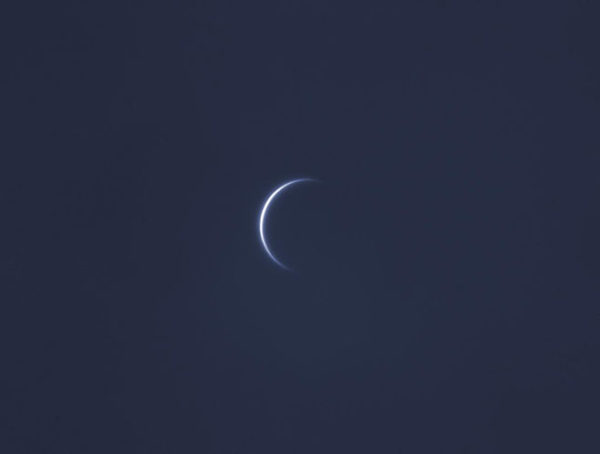 In its crescent phase as viewed from Earth, Venus can give us atmospheric data. Image credit: Chris Shur of http://www.schursastrophotography.com/.
In its crescent phase as viewed from Earth, Venus can give us atmospheric data. Image credit: Chris Shur of http://www.schursastrophotography.com/.
And if we're lucky enough to get a thin crescent phase in our data (not good enough for a transit, but still a good alignment), we might be able to tease out some atmospheric signals as well. This isn't able to be done with the present data that we have, but it might be good enough to do with the present technology that we have. And based on the amount of light we do see -- atmospheric information aside -- we should be able to infer some combination of albedo (reflectivity) and radius based on the amount of light we receive, with some degeneracy there.
The relative sizes of a number of objects, including the three (known) members of Alpha Centauri triple system and some other stars for which the angular sizes have also been measured. Image credit: ESO.
From eric on the size of Proxima Centauri: "They also show a graphic of star sizes to provide some context. Don’t know if their graphic is accurate or not, but on it, Proxima Centauri is just a bit bigger than Jupiter."
First off, there's a whole slew of ESO release images available. Above is the size comparison between various stars, and yes, red dwarfs are tiny! What's interesting is that planets don't get much larger than Jupiter, for the same reason that Jupiter -- three times the mass of Saturn -- is only about 18% larger in radius. At some point, the amount of mass you add begins compressing the atoms at the center by a greater amount than new atoms on the outer layers add to a mass' size. At about 10 Jupiter masses, the radius actually begins decreasing until a critical point is reached. When hydrogen fusion begins, at about 7.5% the mass of our Sun (or around 80 Jupiter masses), there's a large increase in radius, as the outward pressure from fusion becomes significant. Initially, the increase is slow, but if you up the mass to 40%, that increase becomes very large as the temperature and rate-of-fusion go way up. Proxima Centauri is only 11% the Sun's mass, and so it's still quite close to Jupiter's size.
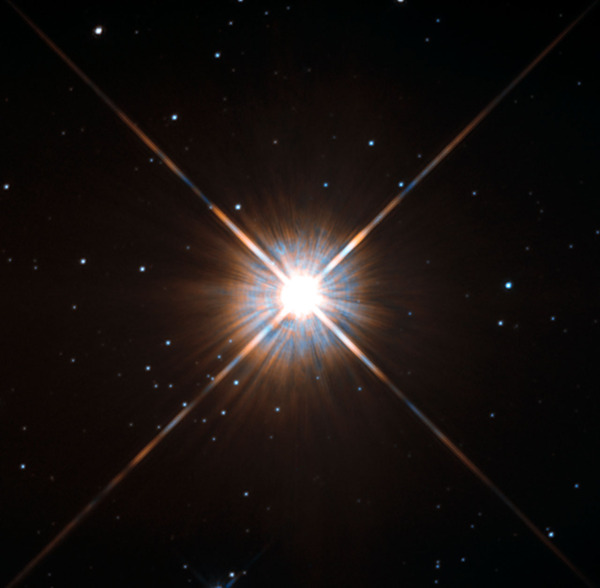 Proxima Centauri, as imaged by Hubble. Image credit: ESA/Hubble & NASA, via http://www.spacetelescope.org/images/potw1343a/.
Proxima Centauri, as imaged by Hubble. Image credit: ESA/Hubble & NASA, via http://www.spacetelescope.org/images/potw1343a/.
From PJ on communication: "NASA’s Pic of the Day commenter states that the planet is close enough for two way communication. What, an 8 and a 1/2 year wait for a reply?"
I wrote to Neil deGrasse Tyson for advice about science communication 9 years ago. He never wrote back or acknowledge my inquiry. (I don't blame him, mind you; it's not like I can respond to more than about 10% of the inquiries I get, or more than 5% of the Ask Ethan submissions!) But if I get one tomorrow, perhaps it was someone on Proxima b picking up the request, taking six months to compose a response and then sending it back!
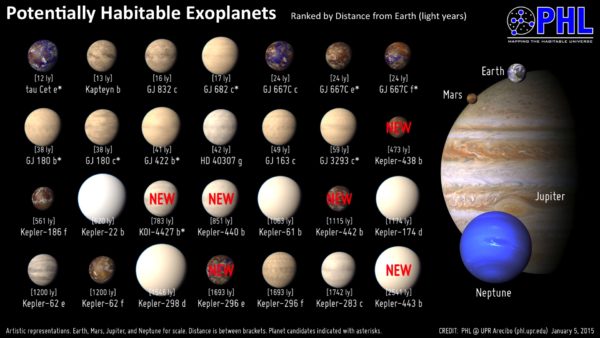 Image credit: PHL @ UPR Arecibo, as of 2015. This number has almost doubled since this image was published, and at a distance of 4.24 light years, Proxima b is now the closest of all.
Image credit: PHL @ UPR Arecibo, as of 2015. This number has almost doubled since this image was published, and at a distance of 4.24 light years, Proxima b is now the closest of all.
From Omega Centauri on the habitability of Proxima b: "Also what does tidal locking do to the atmosphere? If heat transfer from the sunny side to the shadyside is too low, volatiles -including gases other than Hydrogen and Helium might be in the form of a large frozen mass on the shady side.
Far more things could go wrong as far as creating a habitable world than could go right."
There are a lot of different aspects at play for a world around a red dwarf than a world around a G-class star like ours. Including:
- More solar flares and a greater solar wind,
- A near-guarantee of tidal locking,
- A dearth of UV radiation,
and much more. Here's another question: does this make life less likely, or more likely? These different conditions have not been studied at all. For an interesting consideration of these and many other issues, I highly recommend Lee Billings' excellent (and award-winning) book, Five Billion Years Of Solitude.
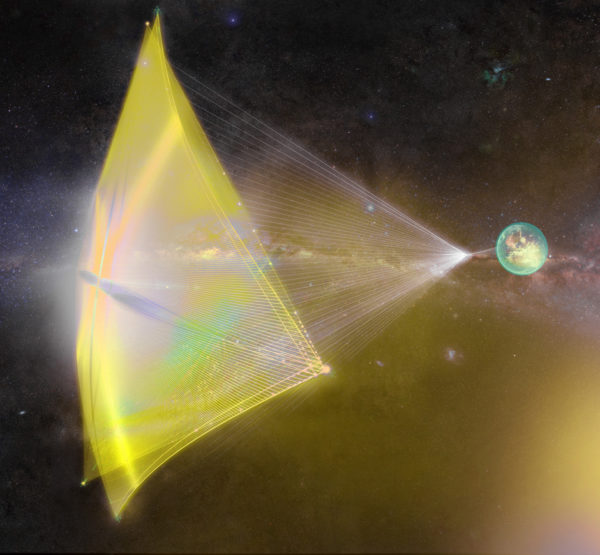 If you don’t mind your spacecraft payload being the size of a microchip, a laser sail could get you up to 20% the speed of light. Image credit: Breakthrough Starshot, of the laser sail concept for a “starchip” spaceship.
If you don’t mind your spacecraft payload being the size of a microchip, a laser sail could get you up to 20% the speed of light. Image credit: Breakthrough Starshot, of the laser sail concept for a “starchip” spaceship.
From Anonymous Coward on a starshot journey: "Sending a robotic probe to Proxima Centauri at 0.2c would be a daunting challenge to say the least. [...] Most treatments of relativistic spaceflight in fiction I’ve seen seem to gloss over this particular detail. Space, while mostly empty, is not completely empty, and when you’re moving at an appreciable fraction of the speed of light even grains of sand have the energy of bombs."
Based on the density of the interstellar medium and assuming one encounters only single atoms at 0.2c, a one-way trip from Earth to Proxima b would erode 0.5mm of matter from the entire assembly along the way. Anything bigger than single atoms... well, the math is not hard to do, and the answer is incineration.
Planets with the same mass and radius as Earth, even in a star’s habitable zone, could have vastly different properties today. Image credit: J. Pinfield / RoPACS network / University of Hertfordshire.
And finally from DeafScribe on how one reacts to this discovery: "There is something dead in people who greet one of the greatest discoveries ever made with snark and cynicism."
And that is why I said "If this doesn’t inspire you to invest in astronomy and learning more about the Universe, perhaps nothing will!" There are reasons to believe this is a grand, daunting challenge for humanity: to learn more about and perhaps even journey to this distant world. It won't be easy, and we may fail. But for me... it's too incredible to imagine that we wouldn't try. We've got to try, whether it's now, in 5 years or 50 years, whenever the technology and the money is there. But I'll be advocating for it every day that I have an opportunity, because the potential rewards are too great, no matter what the outcome is.
Don't you want to know?


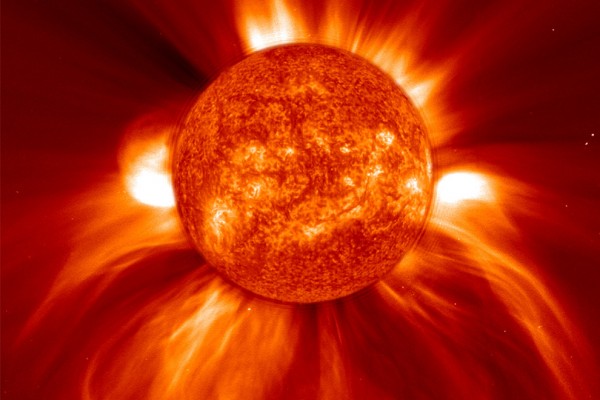
Thinking about the potential resolution of satellite imagery...
We are trying to image an object on the bottom of a swimming pool, wave motion of the surface is constantly defocusing the image. If I assume the blurring occurs at a height of 5KM and
is a single arc second, I get atmospheric blurring as about 24cm. So the announced which implies that getting better than that is likely to be quite difficult. Perhaps taking hundreds
of imagines of the same small target, and using fancy processing might be able to tease better resolution from a few high-value targets, but the cost of the date storage and processing (if even possible) would be prohibitive for general mapping.
Dear Ethan,
It looks likely that a peer reviewed paper on the EMdrive will soon be published in the American Institute of Aeronautics and Astronautics Journal of Propulsion and Power.
Do you have any opinions or speculations about this subject that you can express before the paper is presented?
What will be the impact on the science community if the EMdrive paper is positive?
Four LY away is a challenge and we should go for it. If microwave electrical dispersion from greater too lesser works.
@axil #2
Yes. You can read @Ethan's thoughts here:
https://medium.com/starts-with-a-bang/how-to-fool-the-world-with-bad-sc…
In the science community, anyone who has attached their name to the paper will have permanently lost their 'street cred'.
“And you know how I perceived one of the most *glorious* events in the universe? With these *ridiculous* gelatinous orbs in my skull!”
See Noevo: “Spoken as an honest, transparent evolutionist.”
Ethan: “That’s not the context of this at all… It’s not about evolution at all…”
Whether stated by a fictitious human-like robot (cylon?)
or by the sci fi writers who created the TV episode
or by you,
my statement holds. If he or they or you were to think just a little harder, you all would realize that your thinking is *also* ridiculous, including your assessment of what is “glorious.”
How does a random, non-rational process (i.e. evolution) produce a non-random thing called rationality?
How would a non-rational being determine that it is now, by some unseen/unknown mutation, rational?
“But I’ll be advocating for it every day that I have an opportunity, because the potential rewards are too great, no matter what the outcome is.”
The potential REWARDS are too GREAT,
NO MATTER what the OUTCOME is?
Really?
What are the potential rewards, in general?
What are the potential rewards even if the outcome is a total mission disaster?
“Don’t you want to know?”
I know I don’t want you in charge of giving the go-ahead.
In answering
if sn had decided for once in his posting life to be honest, his "answer" in #6 would have been
instead of the foolishness he typed.
@Ethan wrote
This is what has me so bent out of shape about WFIRST. The total budget for DigitalGlobe's WorldView-4, including design from the ground up, construction, launch, and insurance is US$835 million. From proposal to first light is 9 years.
Contrast that with NASA who doesn't have to pay to design or build the KH11 2.4m Stubby Hubbles. Even with the massive head start NASA needs US$2.7 billion (and rising), and 15-20 years.
If NASA had given the KH11's to DigitalGlobe (née GeoEye) and committed to purchasing US$2.7 billion of telescope time from them, we'd already have both in orbit.
Given that you yourself seem to be an exemplar here,* those bootstraps appear to be yours to explain pulling on.
* Gentlemen's D− on the Turing test notwithstanding.
One problem you forgot in the idea of high res satellite images is the cost in transmitting those images to earth from the satellite. That's a lot of energy or a very low rate of pictures to run with there.
Not to mention that there's a scale problem: picture density goes as the square of the pixel size, but the rate of data transfer possible goes somewhere between the square and less than linear, depending on what you allow to change to get the data rate.
Data transmission is an issue with deep space probes, but it isn't a big issue with satellites. We already have satellites flying with 10 Gbps downlinks.
No, it's a big issue for satellites. It takes energy to transmit high speed.